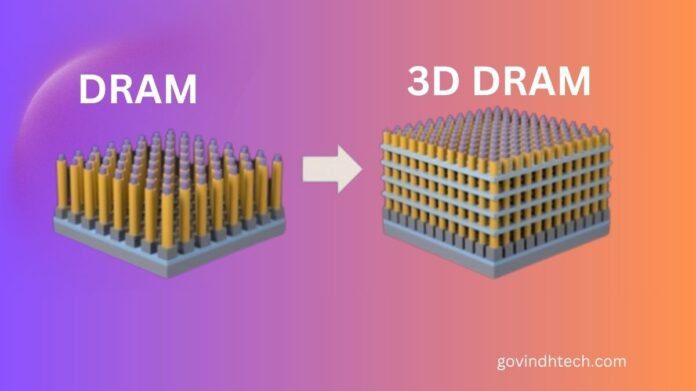Samsung 3D DRAM
3D DRAM
As chip line widths become closer to 10nm and smaller, traditional DRAM (Dynamic Random Access Memory) technology is approaching its physical limits. In order to get over these obstacles and push memory capacity even further, Samsung is leading the charge on the development of 3D DRAM, a ground-breaking technology that has the ability to completely change the memory market.
This article examines Samsung’s 3D DRAM technology, its cutting-edge attributes, and its expected influence on computing in the future.
3D dram Samsung
Samsung Electronics intends to provide the newest technology that will enable the markets to advance into the future as it joins the emerging 3D DRAM industry.
As the first company to enter the 3D DRAM era, Samsung is planning to reveal solutions throughout this decade
The DRAM market had been rather quiet for the previous several quarters, and it seemed that businesses were occupied with battling their stringent financial circumstances in the face of enormous inventories and weak customer demand.
The situation has finally improved, and the emphasis is now on next-generation research and development. This time, Samsung has developed its own 3D DRAM implementation, which should be implemented within the next year.
Sub-10nm compress lines are being used by the DRAM industry, according to presentation slides that have surfaced. Samsung plans to launch two new techniques, dubbed Vertical Channel Transistors and Stacked DRAM, to break the impasse in the development of cutting-edge modern DRAM technologies. These techniques involve different component placements, which ultimately result in lower device area occupation and higher performance.
Similar to this, Samsung intends to use the stacked DRAM approach to boost memory capacities. This will enable the company to get a greater storage-to-area ratio and eventually raise chip capacities to 100 GB. However, Samsung 3D DRAM is expected to reach $100 billion by 2028. Samsung seems to be ahead of the curve in development, indicating it will dominate the DRAM industry. Nevertheless, it is too soon to tell for sure at this point.
Climbing Over the Wall of Scaling: Why 3D DRAM?
The two-dimensional, flat design of current 2D DRAMs is dependent on this. It is harder to fit more transistors into a given area as chip features get smaller. In conventional DRAM, this “scaling wall” prevents future gains in capacity and performance.
This problem is addressed by Samsung 3D DRAM by adding a vertical dimension. Samsung’s strategy makes use of two important technologies:
A major change in transistor design is represented by vertical channel transistors, or VCTs. By positioning the current flow channel vertically rather than horizontally, VCTs enable tighter packing and drastically reduce the transistor footprint.
Multiple layers of memory cells are vertically stacked inside a single chip using the stacked DRAM technology. Rather of distributing memory over one level, picture erecting a skyscraper. By using this novel technique, single-chip capacity might be increased to an astounding 100GB, which would be a significant improvement over the present limits.
Samsung’s Assured Leadership in 3D DRAM
Samsung has made significant investments to create 3D DRAM.
The following are some crucial markers of their dedication:
- New Research facility: In order to expedite the development of next-generation 3D DRAM solutions, Samsung has established a specialised research facility in Silicon Valley.
- Highlighting Sub-10nm DRAM for sub-10nm DRAM techniques, Samsung is customising 3D architectures, which will allow for large capacity gains in next chips.
- Extended Timetable: Samsung’s long-term memory plan places a strong emphasis on 3D DRAM as a testament to their faith in the technology’s transformational potential.
Applications and Advantages of Samsung 3D DRAM
The consequences of developing 3D DRAM successfully are extensive.
Here’s what to anticipate:
- Greater Memory Capacity: Samsung 3D DRAM is expected to provide much bigger memory capacities per chip, enabling the development of potent devices with hitherto unheard-of memory capacities.
- Improved Performance: Since VCTs have a smaller transistor footprint, they may use less power and transport data more quickly.
- Revolutionized Applications: The enhanced memory bandwidth and capacity provided by 3D DRAM will be very beneficial to high-performance computing, artificial intelligence, and big data applications.
Looking Ahead: Samsung 3D DRAM’s Future
Though 3D DRAM development is still in its infancy, Samsung is leading the way. Industry experts predict a commercial debut by 2025 at the latest.
These are a few of the current difficulties:
- Manufacturing Complexity: Significant breakthroughs in fabrication technologies are necessary to correctly stack numerous memory layers.
- Cost considerations: The initial cost of developing and adopting this new technology may have an influence on manufacturing costs.
Notwithstanding these obstacles, Samsung 3D DRAM is an eagerly awaited breakthrough due to Samsung’s dedication and the possible advantages. It might bring in a new age of processing power and redefine memory capacity.
What it is:
As chip sizes decrease, Samsung’s 3D DRAM is a ground-breaking memory technology intended to get beyond the drawbacks of conventional 2D DRAM.
Important characteristics:
- Transistors having a vertical current flow, or vertical channel transistors (VCTs), allow for denser packing and smaller dimensions.
- Stacked DRAM: Increases possible capacity to 100GB per chip by vertically stacking many memory layers on a single chip.
Advantages:
- Increased memory capacity: Provides very strong devices with memory capacities never before seen.
- Improved performance: Faster data transmission and less power consumption are caused by smaller transistors.
- Applications that have been revolutionised: improves big data, AI, and high-performance computing performance.
Present Phase:
- Early development phase, with a 2025 or later commercial launch anticipated.
- Difficulties include perhaps expensive starting expenses and intricate production procedures.
Overall Importance:
Samsung’s 3D DRAM might bring in a new age of computer power and revolutionise memory possibilities.

